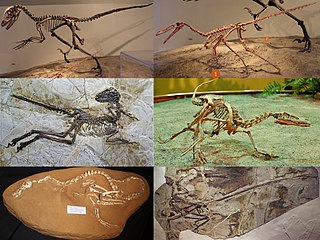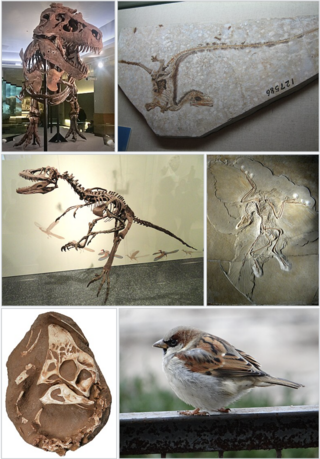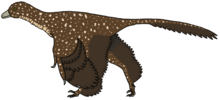
Deinonychosauria is a clade of paravian dinosaurs which lived from the Late Jurassic to the Late Cretaceous periods. Fossils have been found across the globe in North America, Europe, Africa, Asia, South America, and Antarctica, with fossilized teeth giving credence to the possibility that they inhabited Australia as well. This group of dinosaurs are known for their sickle-shaped toe claws and features in the shoulder bones.

Dromaeosauridae is a family of feathered coelurosaurian theropod dinosaurs. They were generally small to medium-sized feathered carnivores that flourished in the Cretaceous Period. The name Dromaeosauridae means 'running lizards', from Greek δρομαῖος (dromaîos), meaning 'running at full speed', 'swift', and σαῦρος (saûros), meaning 'lizard'. In informal usage, they are often called raptors, a term popularized by the film Jurassic Park; several genera include the term "raptor" directly in their name, and popular culture has come to emphasize their bird-like appearance and speculated bird-like behavior.

Microraptor is a genus of small, four-winged dromaeosaurid dinosaurs. Numerous well-preserved fossil specimens have been recovered from Liaoning, China. They date from the early Cretaceous Jiufotang Formation, 125 to 120 million years ago. Three species have been named, though further study has suggested that all of them represent variation in a single species, which is properly called M. zhaoianus. Cryptovolans, initially described as another four-winged dinosaur, is usually considered to be a synonym of Microraptor.

Maniraptora is a clade of coelurosaurian dinosaurs which includes the birds and the non-avian dinosaurs that were more closely related to them than to Ornithomimus velox. It contains the major subgroups Avialae, Dromaeosauridae, Troodontidae, Oviraptorosauria, and Therizinosauria. Ornitholestes and the Alvarezsauroidea are also often included. Together with the next closest sister group, the Ornithomimosauria, Maniraptora comprises the more inclusive clade Maniraptoriformes. Maniraptorans first appear in the fossil record during the Jurassic Period, and survive today as living birds.

Coelurosauria is the clade containing all theropod dinosaurs more closely related to birds than to carnosaurs.

A feathered dinosaur is any species of dinosaur possessing feathers. That includes all species of birds, and in recent decades evidence has accumulated that many non-avian dinosaur species also possessed feathers in some shape or form. The extent to which feathers or feather-like structures were present in dinosaurs as a whole is a subject of ongoing debate and research.

Jinfengopteryx is a genus of maniraptoran dinosaur. It was found in the Qiaotou Member of the Huajiying Formation of Hebei Province, China, and is therefore of uncertain age. The Qiaotou Member may correlate with the more well-known Early Cretaceous Yixian Formation, and so probably dates to around 122 Ma ago.

Scansoriopteryx is a genus of maniraptoran dinosaur. Described from only a single juvenile fossil specimen found in Liaoning, China, Scansoriopteryx is a sparrow-sized animal that shows adaptations in the foot indicating an arboreal (tree-dwelling) lifestyle. It possessed an unusual, elongated third finger which may have supported a membranous wing, much like the related Yi qi. The type specimen of Scansoriopteryx also contains the fossilized impression of feathers.

Scansoriopterygidae is an extinct family of climbing and gliding maniraptoran dinosaurs. Scansoriopterygids are known from five well-preserved fossils, representing four species, unearthed in the Tiaojishan Formation fossil beds of Liaoning and Hebei, China.

Jeholornis is a genus of avialan dinosaurs that lived between approximately 122 and 120 million years ago during the early Cretaceous Period in China. Fossil Jeholornis were first discovered in the Jiufotang Formation in Hebei Province, China and additional specimens have been found in the older Yixian Formation.

The scientific question of within which larger group of animals birds evolved has traditionally been called the "origin of birds". The present scientific consensus is that birds are a group of maniraptoran theropod dinosaurs that originated during the Mesozoic era.

Avialae is a clade containing the only living dinosaurs, the birds, and their closest relatives. It is usually defined as all theropod dinosaurs more closely related to birds (Aves) than to deinonychosaurs, though alternative definitions are occasionally used.

Paraves are a widespread group of theropod dinosaurs that originated in the Middle Jurassic period. In addition to the extinct dromaeosaurids, troodontids, anchiornithids, and possibly the scansoriopterygids, the group also contains the avialans, which include diverse extinct taxa as well as the over 10,000 species of living birds.

Epidexipteryx is a genus of small maniraptoran dinosaurs, known from one fossil specimen in the collection of the Institute of Vertebrate Paleontology and Paleoanthropology in Beijing. Epidexipteryx represents the earliest known example of ornamental feathers in the fossil record.

Anchiornis is a genus of small, four-winged paravian dinosaurs, with only one known species, the type species Anchiornis huxleyi, named for its similarity to modern birds. The Latin name Anchiornis derives from a Greek word meaning "near bird", and huxleyi refers to Thomas Henry Huxley, a contemporary of Charles Darwin.

Xiaotingia is a genus of anchiornithid theropod dinosaur from Middle Jurassic or early Late Jurassic deposits of western Liaoning, China, containing a single species, Xiaotingia zhengi.

Eosinopteryx is an extinct genus of theropod dinosaurs known to the Late Jurassic epoch of China. It contains a single species, Eosinopteryx brevipenna.

Serikornis is a genus of small, feathered anchiornithid dinosaur from the Upper Jurassic Tiaojishan Formation of Liaoning, China. It is represented by the type species Serikornis sungei.

Anchiornithidae is a family of small paravian dinosaurs. Anchiornithids have been classified at varying positions in the paravian tree, with some scientists classifying them as a distinct family, a basal subfamily of Troodontidae, members of Archaeopterygidae, or an assemblage of dinosaurs that are an evolutionary grade within Avialae or Paraves.





























